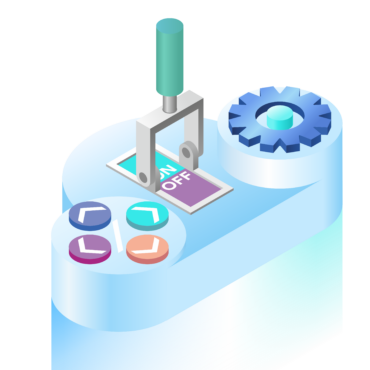SaaS: Streamlining Modern Business Operations through Cloud Technology
Updated 24 May 2024
Software as a Service (SaaS) has emerged as a revolutionary model that has transformed the way businesses operate. SaaS harnesses the power of the cloud to provide accessible, scalable, and flexible software solutions that cater to the dynamic needs of modern enterprises. This article will delve into the core of SaaS, exploring its benefits, challenges, and the pivotal role it plays in the contemporary business landscape for companies.
What is SaaS?
SaaS stands for Software as a Service, a software distribution model in which applications are hosted by a third-party provider and made available to customers over the internet. This model allows businesses to access software applications on a subscription basis without the need for internal infrastructure or hardware. The allure of SaaS lies in its simplicity and efficiency, offering users the ability to access powerful applications via a web browser, irrespective of their location.
An important aspect of SaaS is that it removes the necessity for organizations to install and run applications on their own computers or in their own data centers. This results in significant cost savings as it eliminates expenses related to hardware acquisition, provisioning, and maintenance, as well as software licensing, installation, and support. This aspect of SaaS not only reduces costs but also simplifies the process of using and maintaining software applications for businesses.
The Evolution of SaaS
The journey of SaaS from a niche concept to a mainstream business solution is underpinned by the evolution of cloud computing. Initially, businesses had to rely on on-premises solutions, which involved significant upfront costs, ongoing maintenance, and complex updates. However, the advent of cloud technology paved the way for the SaaS model, where applications are hosted on remote servers and maintained by providers. This shift not only reduced costs but also alleviated the burden of software management from the shoulders of businesses.
The Role of Cloud Computing
The evolution of SaaS is deeply intertwined with the evolution of cloud computing. In the early days, businesses had to rely on on-premises solutions, which involved significant upfront costs, ongoing maintenance, and complex updates. However, the advent of cloud technology paved the way for the SaaS model, where applications are hosted on remote servers and maintained by providers. This shift not only reduced costs but also alleviated the burden of software management from the shoulders of businesses.
The Impact of Mobile Technology
An additional key factor in the evolution of SaaS has been the rise of mobile technology. With the proliferation of smartphones and tablets, the demand for accessible, on-the-go solutions has skyrocketed. This has led to the development of mobile-friendly SaaS applications, allowing users to access their software anytime, anywhere. This further enhances the flexibility and convenience offered by the SaaS model, making it an increasingly popular choice for businesses and individuals alike.
The evolution of SaaS has been driven by technological advancements and changing user needs, with cloud and mobile technologies playing pivotal roles. As these technologies continue to evolve, we can expect to see further developments and innovations in the SaaS landscape.
Key Features of SaaS
The defining characteristics of SaaS include its subscription-based pricing model, which often operates on a monthly or annual basis. This approach offers flexibility and scalability to businesses, allowing them to adjust their usage and costs according to their needs. Furthermore, SaaS providers take responsibility for the maintenance, management, and security of the software, ensuring that businesses always have access to the latest updates and innovations without additional charges.
Advantages of SaaS for Businesses
Adopting a SaaS model presents multiple advantages for businesses across various industries:
Cost Efficiency: By eliminating the need to purchase, install, and maintain hardware and software, SaaS significantly cuts costs. This is particularly beneficial for small to medium-sized enterprises that may not have the capital for large IT investments.
Scalability and Flexibility: SaaS applications can easily scale up or down based on user demand, offering businesses flexibility as they grow or experience fluctuations in workload.
Accessibility and Collaboration: With applications hosted in the cloud, users can access their software from anywhere using the internet. This facilitates better collaboration among teams, especially in remote or hybrid work environments.
Enhanced Security: SaaS providers invest heavily in security measures to protect customer data and ensure compliance with regulations. This is often more robust than what businesses can achieve on their own.
Disadvantages of SaaS
While Software as a Service (SaaS) offers numerous advantages to businesses, there are also some inherent disadvantages that organizations should consider before fully adopting this model. Here are some of the key disadvantages associated with SaaS:
Dependence on Internet Connectivity
SaaS applications require a stable and fast internet connection for optimal functionality. If a company’s internet service is unreliable, it can hinder access to critical applications and data, potentially disrupting business operations.
Limited Control
Since SaaS applications are managed by third-party vendors, businesses have less control over the performance and availability of their software. This can be a significant drawback during outages or when specific customization or integration is required that the service provider does not support.
Data Security Concerns
Although SaaS providers generally offer robust security measures, hosting sensitive data on external servers and transmitting it over the internet introduces risks. Companies must rely on the provider’s ability to secure data and protect privacy, which can be a particular concern for industries subject to stringent regulatory compliance regarding data handling and protection.
Vendor Lock-in
Switching SaaS providers can be challenging and costly, especially when data transfer and system reconfiguration are involved. Businesses may find themselves dependent on a particular service provider, which can limit flexibility and bargaining power.
Customization Limitations
SaaS applications often come with preset configurations that may not fit every business’s unique needs. While some level of customization is usually possible, it is typically more limited compared to traditional on-premises software solutions. This can make it difficult for companies to tailor the software to their specific processes or requirements.
Ongoing Costs
Although SaaS can reduce upfront costs, the subscription-based pricing model can lead to higher operational expenses over time. For businesses that use multiple SaaS solutions extensively, the cumulative cost can be substantial, especially as prices may increase upon contract renewal.
Integration Issues
Integrating SaaS applications with existing on-premises systems or other cloud services can be complex and may require additional tools or services. This integration is crucial for seamless operation but can be a technical challenge and might require ongoing maintenance and support.
Performance Variability
Performance of a SaaS application can depend on factors outside of a business’s control, such as the provider’s server capacity and the amount of traffic from other users. This can lead to variability in application performance and response times, affecting user experience and productivity.
Data Mobility and Portability
Moving data in and out of a SaaS application can be complicated, especially if a business decides to change providers or bring services back in-house. Data export features may not be comprehensive, and there can be compatibility issues with new software environments.
By carefully considering these disadvantages alongside the advantages, businesses can make more informed decisions about implementing SaaS solutions and plan strategies to mitigate potential risks.
Challenges and Considerations
Despite its numerous benefits, the SaaS model also presents challenges that businesses must consider:
Dependence on Providers: Relying on third-party providers for critical business functions can pose risks, particularly if the provider experiences downtime or security breaches.
Data Security Concerns: While providers typically offer strong security measures, the transfer and storage of data off-premises can be a concern for some businesses, especially those handling sensitive information.
Customization Limitations: Some SaaS applications may not offer the same level of customization as on-premises solutions, which can be a limitation for companies with specific needs.
The Future of SaaS
Looking ahead, the future of SaaS is filled with exciting possibilities for continued growth and innovation. Advances in AI and machine learning are set to further enhance SaaS offerings, providing businesses with more intelligent and adaptive solutions.
AI-powered SaaS applications have the potential to revolutionize various aspects of business operations. For example, machine learning algorithms can analyze vast amounts of data to uncover patterns and insights that humans might miss. This can lead to more accurate predictions and better decision-making. AI can also automate routine tasks, freeing up time and resources for employees to focus on more strategic activities.
Moreover, the increasing emphasis on data security and privacy will drive improvements in how SaaS providers manage and protect user data. As data breaches become more prevalent, businesses are becoming increasingly concerned about the safety of their sensitive information. SaaS providers will need to invest in robust security measures, such as encryption, multi-factor authentication, and data anonymization, to ensure the confidentiality and integrity of their customers’ data. Additionally, compliance with data protection regulations, such as GDPR and CCPA, will become even more critical.
Another aspect of the future of SaaS is the integration and interoperability of different software applications. Businesses often use multiple SaaS solutions to meet their various needs, such as customer relationship management, project management, and accounting. Seamless integration between these applications will become crucial to streamline workflows and improve efficiency. SaaS providers will need to invest in building APIs and developing partnerships to enable smooth data exchange and collaboration between different software systems.
Furthermore, as technology continues to advance, SaaS solutions will become more accessible and user-friendly. The user interface and experience will continue to evolve, making it easier for non-technical users to navigate and utilize SaaS applications. This will empower businesses of all sizes to leverage the benefits of SaaS without requiring extensive technical expertise or training.
In summary, the future of SaaS is bright and promising. Advancements in AI, increased emphasis on data security, improved integration capabilities, and enhanced user experience are just a few of the exciting developments on the horizon. As businesses continue to rely on SaaS to streamline their operations, the industry will adapt and innovate to meet their evolving needs.
Conclusion
SaaS represents a paradigm shift in the way companies utilize software. For businesses like Ostride Labs, adopting SaaS means embracing a model that not only reduces costs and increases efficiency but also fosters innovation by making state-of-the-art software accessible. As the digital landscape evolves, SaaS will undoubtedly play a crucial role in shaping the future of business operations, enabling companies to stay competitive and responsive to changing market demands.


